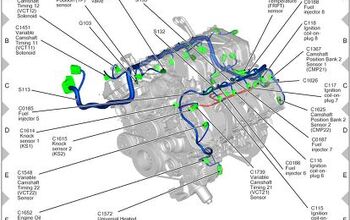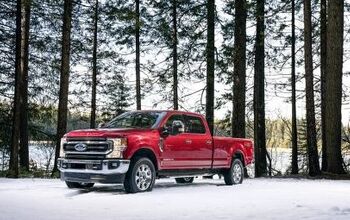V8's Rule!
In contrast, inline four cylinder engines are inherently unbalanced. Because of the geometry of the crankshaft and rods within the engine, fours shake in both the horizontal and vertical planes. There’s only one way to mitigate the effect: add unbalanced shafts to create counter-vibrations. This “fix” adds weight, complexity and cost. Even so, the inherent vibrations from a four cylinder engine wreak havoc on accessories and require extra mass in all the mounting brackets and related parts. In fact, by the time a four cylinder engine is tamed, it weighs and costs almost as much as a V8. And the customer still suffers the noise and vibration penalties that come from skimping on cylinders.
V6’s also have inherent imbalances, though not nearly as severe as a four. Depending on the block angle, V6 engine operation creates vertical or horizontal forces. The most sophisticated V6 engines also have balance shafts, again adding to complexity, cost and weight. Fives, threes and twos have even worse vibrations, some beyond simple analysis. V10’s add the vibrations of two five cylinder engines together, which is better at some speeds, worse at others. Turbocharging or supercharging four or six cylinder engines to get to V8 power levels simply adds more complexity and weight to an already challenged engine design, and sacrifices the low end torque of a naturally aspirated powerplant. (Just ask Mercedes’ AMG division, who’ve recently switched from supercharged eights and sixes normally aspirated 6.3-liter V8's.)
Odd numbers of cylinders, like three or five, are inevitably the result of cost-cutting. Sometimes there’s no time or money to tool for a smaller engine, so a few cylinders are lopped off an existing engine. That’s why GM’s lackluster small pickup trucks and the Hummer H3 sport a five cylinder engine. Ten cylinder engines, currently deployed in Vipers and some Dodge and Ford trucks, are another cost-cutting move. Engine not powerful enough? Add two more similar cylinders and call it good.
The provision of V12 engines in luxury cars is even more perverse. V12’s are no smoother than a V8 and add (you guessed it) weight, complication and cost. While that may be the manufacturer’s intent, it still makes little engineering sense. Jaguar gave up on V12’s a while ago. Aston Martin passed on their V12 to offer a V8 in their latest car. In fact, thanks to the V8’s relatively light weight, good power output and compact packaging, the engine configuration is, belatedly, making gains in the European market. BMW, Mercedes, Volvo and Audi all offer Euro-spec V8 passenger cars.
Once you’ve committed to a V8, there are a lot of reasons for making it a pushrod. A single camshaft simplifies a lot of things, and the narrow heads associated with pushrod engines allow greater flexibility in vehicle packaging. Thus smaller cars can enjoy a V8 engine. Before the outraged techno-comments start dropping at the feet of this post, it should be noted that the most powerful racing engines in the world are pushrod V8s, with two valve heads to boot. Some of the fastest cars you can buy in America have pushrod, two valve V8’s. The Chevrolet Corvette is only the most prominent example.
So why don’t all cars have V8’s? The answer lies in marketing, rather than engineering. Marketing has declared that V8 engines are best suited to high-end, high performance cars, while the masses should get by with “economical” fours and sixes. The public now believes that V8 means bad mileage. The opposite is true– at least potentially. Mileage depends on two factors: the weight of the car and how fast you go. Engine size and cylinder count have little to do with it. Of course, bigger engines encourage people to accelerate and drive faster, but that’s not the engine’s fault. And new technology is mooting the V8 as gas-guzzler argument. Multi-displacement systems (a fancy way of saying that four cylinders go on vacation when not needed) have the potential to dramatically increase V8 mileage under light load conditions.
In short, for pistonheads at least, the five saddest words in the English language are still “I could’ve had a V8”.
More by Bob Elton
Latest Car Reviews
Read moreLatest Product Reviews
Read moreRecent Comments
- Dave M. IMO this was the last of the solidly built MBs. Yes, they had the environmentally friendly disintegrating wiring harness, but besides that the mechanicals are pretty solid. I just bought my "forever" car (last new daily driver that'll ease me into retirement), but a 2015-16 E Class sedan is on my bucket list for future purchase. Beautiful design....
- Rochester After years of self-driving being in the news, I still don't understand the psychology behind it. Not only don't I want this, but I find the idea absurd.
- Douglas This timeframe of Mercedes has the self-disintegrating engine wiring harness. Not just the W124, but all of them from the early 90's. Only way to properly fix it is to replace it, which I understand to be difficult to find a new one/do it/pay for. Maybe others have actual experience with doing so and can give better hope. On top of that, it's a NH car with "a little bit of rust", which means to about anyone else in the USA it is probably the rustiest W124 they have ever seen. This is probably a $3000 car on a good day.
- Formula m How many Hyundai and Kia’s do not have the original engine block it left the factory with 10yrs prior?
- 1995 SC I will say that year 29 has been a little spendy on my car (Motor Mounts, Injectors and a Supercharger Service since it had to come off for the injectors, ABS Pump and the tool to cycle the valves to bleed the system, Front Calipers, rear pinion seal, transmission service with a new pan that has a drain, a gaggle of capacitors to fix the ride control module and a replacement amplifier for the stereo. Still needs an exhaust manifold gasket. The front end got serviced in year 28. On the plus side blank cassettes are increasingly easy to find so I have a solid collection of 90 minute playlists.


































Comments
Join the conversation
Further to gbh's comments: This: "10. Antique cars wioth inline 8, V12 or V16 engines are outside of the scope of this article. As are antique V8 engines with a single plane crankshaft." is cheating. Your article holds up the V8 for all manner of "inherent" engineering advantages. many of which have been successfully countered by the posters here. 4. A boxer engine, 6 cylinders, is basically a V6 with a 180 deg angle. If it has a 6 throw crank, it is pretty good, but there are still rotating vibrations when looking in a plan view. Err, you mean rocking couple? Of what amplitude? "rotating vibrations in a plan view" - so that's how you describe the picture from Marks that you still appear to be attempting to get your head around? "4 cyl engines tend to have expensive hydraulic motor mounts these days to further isolate the engine. " As do almost all engines, of whatever configuration.... If you're going to whinge about the demise of the V8, why not base the article on why they became unpopular and why and how marketing pushed the car manufacturers in that direction. No mention of an I8?
I'm convinced, although you are preaching to the choir. I wish to God I could've bought a Charger with a 260cid V8 of roughly the same horsepower (250) as the big V6 . I have the 3.5L version. It has good power - at high rpm of course, and you can feel the vibration of it at idle easily from the driver's seat. I'm sure you would get about the same gas mileage under the same conditions too - and with a small V8 you don't have the need for cylinder shutdown. MDS doesn't really do much for real world gas mileage - it's just to trick the EPA computer for CAFE compliance. Good point about weight too. You can quibble, but the most basic physics of the situation say lots of weight is going to take lots of energy to move.